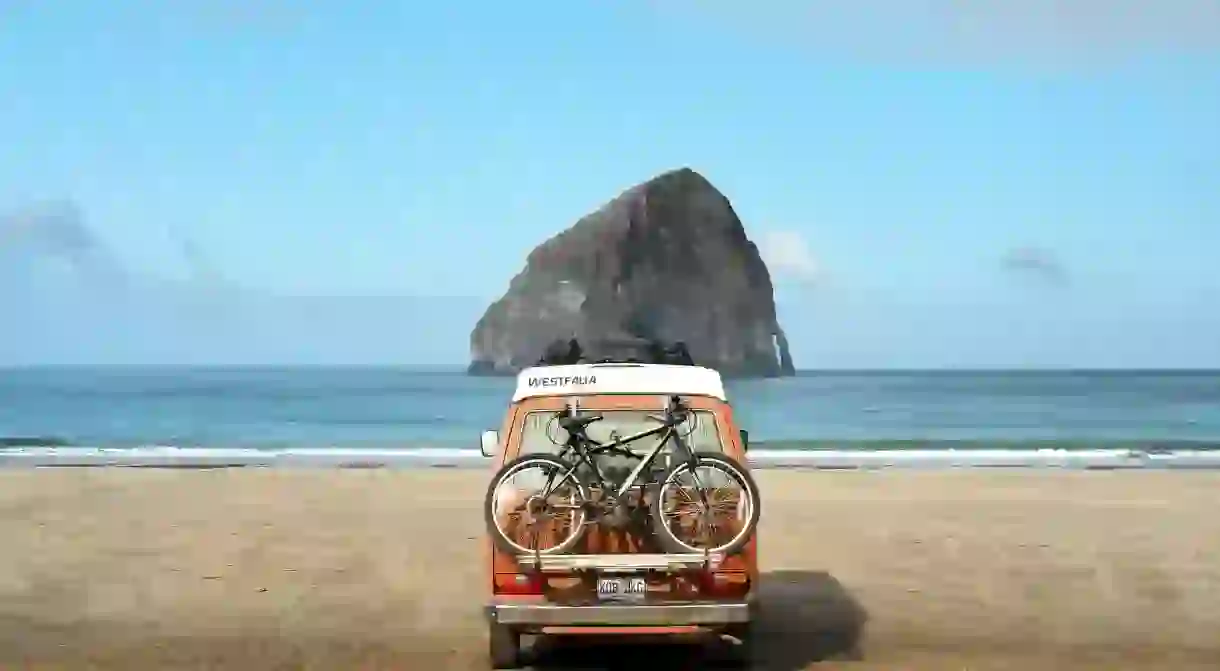‘Van Life’ is Redefining Life on the Road

Nomads are not a new phenomenon. But Instagram and the hashtag #VanLife have re-branded transience, making it the new “cool”.
Van Life: Your Home on the Road by Foster Huntington capitalizes on this trend, offering a diverse collection of vans, some VW, some sprinters, and even a few school buses that have been converted into warm homes. The book is largely a collection of inspirational photos and discussions with van dwellers.

The first chapter of Huntington’s book is dedicated to his own van. “My infatuation with livable vehicles dated back some years prior, to a month-long road trip that I took around California with family in the mid-nineties,” he writes. “It was on this trip that I fell in love with the ease and simplicity of just pulling over to the side of the road to sleep and waking up in a beautiful place.”
Van life is not unlike the minimalism and tiny house movements and, for those interested in living on the road, #VanLife offers inspiration in the form of picturesque images, with van interiors transformed into tiny studio apartments.
Sabrina and Jimmy run the online site Wandxr, where they document their life on the road, traveling across North America. They define van life as “the idea of owning less to see more of the world.”

“Van life is a blank canvas,” Sabrina and Jimmy tell Culture Trip over email. “Each van is set up to match your personality and the lifestyle follows.”
The van lifestyle is especially popular with hikers, rock climbers, and surfers. They can take advantage of the low cost of living and pursue remote locales. Meet-ups and online groups allow van-lifers to network and create a community. This helps members share information about van upkeep and the best sites to camp out in.
“It’s been a wonderful, spontaneous, and passionate adventure,” says Lacey Mayer, who runs The Ladies’ Van Instagram account with her wife Breanne Acio. “It was eye-opening to see how social media can bring people together for real life events … It was inspiring to see so many people following their passions.”

Huntington is actually credited with starting the hashtag when he began his travels in 2011. His account went viral, and #VanLife has come to define the lifestyle.
But Instagram pictures and photography books do have a way of glamorizing the van-life experience. Speaking about connecting with fellow van-lifers, Lacey says “It was apparent the struggles and complications that most nomadic people face, because we could all bond over similar stories. These are the stories that are often not portrayed on our social media accounts.”

Some people on the road express frustration about the way social media portrays van-lifers. The most popular Instagram accounts tend to show young couples, often blonde, often heterosexual, despite the fact that people from all walks of life take to the road. Instagram has a focus on the aesthetics, so more basic van build-outs don’t get the same attention as the nicer and more expensive ones. Some van-lifers subsidize their lifestyle as social media influencers, so they include product placement in their posts.
“It is the complete opposite of what you see on Instagram. It is laughable,” Mikah Meyer of Instagram’s Mikahmey says. His account tries to give a more realistic portrayal of life on the road, sans the heavily posed shots. He laughs about the images of people working on their laptops, parked on a beach. “[Those images are] so so far from my experience being in the van in parking lots and opening the side door to spit out my toothpaste,” he says.

“I dove into it seeing those images and thinking it would be super cool and easy and it’s actually been really hard and really stressful,” Meyer continues. “The reality is that life is hard for everyone and it’s a lot harder in a van. There are a lot of tradeoffs.”
The financial benefits are a large part of the appeal of van life for Meyer. He is working on breaking the record for the youngest person to visit every National Park Service site in the United States. That’s 417 sites in total, in one continuous trip.
“There is no way I could have afforded to do this project on the money I had saved up. If you average hotels at $100 a night, that comes out to $36,500 a year. I’m living in my van that is built out for less that than and I’ve been in it now for a little over two years. [Van life] makes impossible dreams possible.”

It doesn’t take much to get your own van and go off. There are tons of resources with information on how to trick out your own van and where to find other people living on the road. Van conversions range from simply having a bed in the back of a regular car to bigger-budget affairs with solar panels, stoves, sinks, and more.
“Remember, you’re building your van to live out of it instead of in it,” Kathleen, another van-lifer, writes in Huntington’s book. “Choose the adventure that fits your lifestyle and let the rig follow. While your adventuremobile will play a big role in your travels, the time you spend out of it is even more valuable.”
While moving into a van yourself may be too large a commitment, Van Life offers readers the chance to experience the highs of life on the road without leaving their couch.














